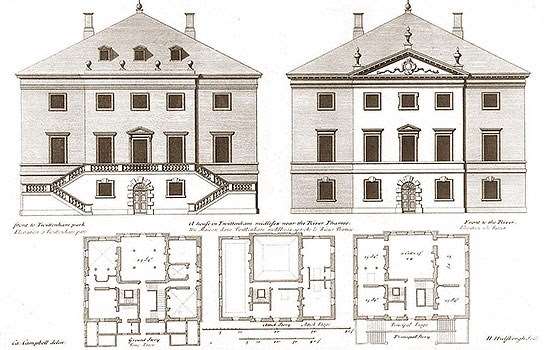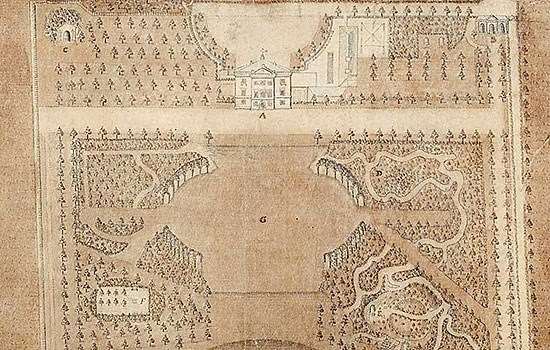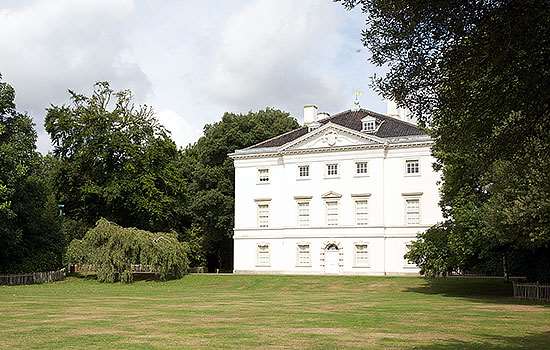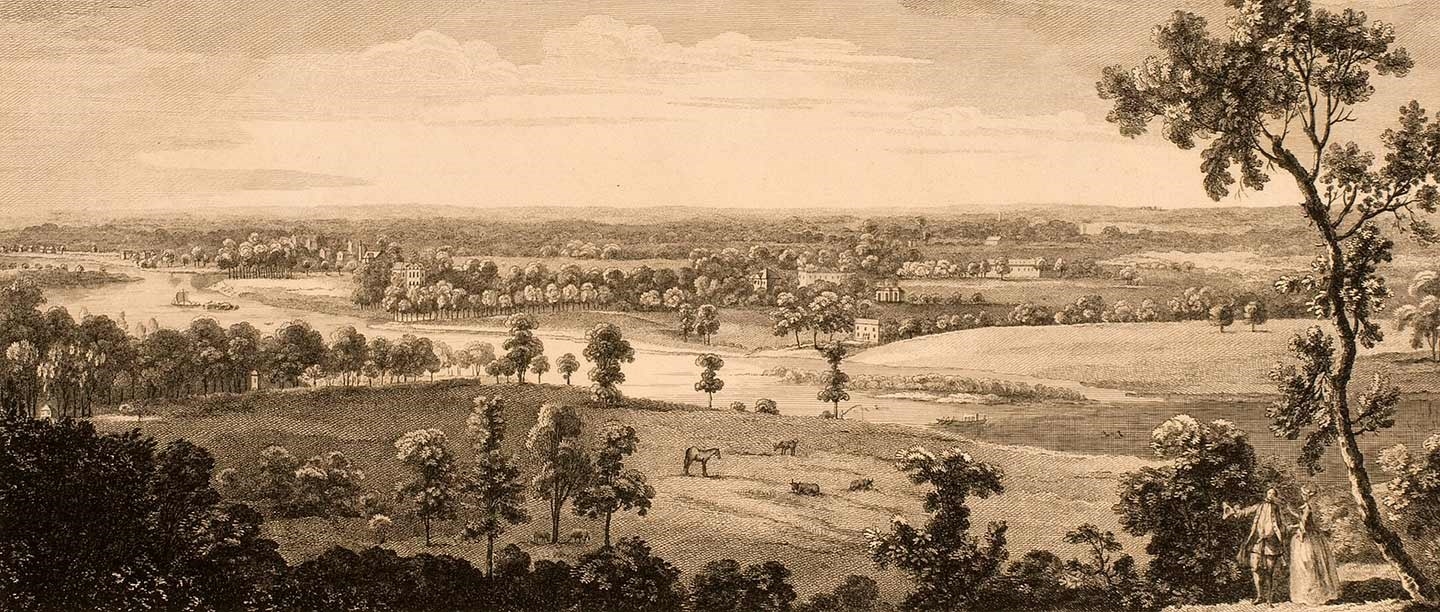Marble Hill, which was built in the 1720s, is clearly visible in Antonio Joli’s A View from Richmond Hill looking South-West. The house lies across the river from the viewpoint, to the right of the canvas. The large building to the left of it, with its distinctive octagonal pavilion, was the home of the MP George Pitt. It has been known since 1815 as Orleans House after its famous resident Louis Philippe, duc d’Orleans (1773–1850). In the distance lies the village of Twickenham. This view was painted in about 1750, while Marble Hill was still home to Henrietta Howard.
Although Joli (1700–77) was born and trained in Italy, the painting shows the influence of the accurate, topographical style introduced to Britain by Dutch and Flemish artists.
A drawing by John Baptiste Claude Chatelain (1710–58) (shown at the top of the page, as engraved by Peter Paul Benazech) shows a similar view in about 1755. The viewpoint is slightly lower, as it was drawn from the Summer House in Richmond Park, and Marble Hill, identified by its pyramidal roof and pediment, is at the centre of the scene. The elegant couple in the foreground and the pleasure barge on the river are reminders of the popularity of this prospect among 18th-century visitors. The view was drawn with the permission of Princess Amelia, second daughter of George II, who became Ranger of Richmond Park in 1751 and restricted public access to the park until 1758.
In contrast, the houses on the far river bank are barely visible in the view of The Thames from Richmond Hill painted in 1788 by Sir Joshua Reynolds (1723–92), who was more interested in composition and tone than precise detail. Reynolds, who became the first president of the newly established Royal Academy in 1768, is better known as a portrait painter, but this landscape held a special appeal for him. From 1771 he had a house on Richmond Hill, Wick House, which he used as a place to entertain guests away from the hustle and bustle of London. It was designed by Sir William Chambers and had a bow window on the first floor from which Reynolds could admire the prospect of the vale of the Thames.
For his painting, Reynolds chose a viewpoint between Wick House and The Star and Garter tavern which had opened in 1738. One of Reynolds’s neighbours was his artistic rival, Thomas Gainsborough (1727–88), who leased No. 2 The Terrace on Richmond Hill towards the end of his life.
The extent of the buildings on the hill itself is shown in a View of the Terrace, Richmond Hill, painted by William Marlow (1740/41–1813) in about 1780. From the end of the 17th century onwards this was a prestigious place to live, with notable houses including No. 3 The Terrace, built in 1767 for the playing card manufacturer Christopher Blanchard. There were also places for entertainment and refreshments, with a theatre opening in 1719 and several taverns, such as the Roebuck, which opened in about 1715.
Marlow was a successful landscape painter who produced many views of this stretch of the Thames. He had moved to the Manor House in Twickenham in about 1775 where his mentor, the marine painter Samuel Scott (1702–72), had previously lived.
Twickenham and Richmond were a hive of artistic activity in the late 18th and early 19th centuries. In 1814 this area became the home of one of Britain’s greatest landscape painters, JMW Turner (1775–1851), who designed and built Sandycombe Lodge (now No. 40 Sandycoombe Road, Twickenham) for himself, very close to Marble Hill.
Sketchbook in hand, Turner made frequent excursions to Richmond Hill. His large-scale painting Thomson’s Aeolian Harp, exhibited in 1809, is the most famous painting of this view. In the foreground he has introduced an imaginary, classical monument – the harp of Aeolus, god of the winds in Greek mythology. On the pedestal of the monument Turner has painted the name ‘THOMSON’. This is a reference to the 18th-century Richmond poet James Thomson, who described the view in his poem ‘Summer’ from The Seasons, first published in 1727 – just as the building works at Marble Hill were under way. Thomson’s poem invites us to ‘trace the matchless vale of Thames; / Far-winding up to where the muses haunt / To Twit’nam’s bowers’.
See more of Turner’s views from Richmond HillBy the 19th century, Marble Hill was no longer visible from Richmond Hill, having been concealed by trees. A View from Richmond Hill, painted by Thomas Christopher Hofland in about 1820 when he lived next to Marble Hill in Montpelier Row, shows only Little Marble Hill, the small white house among the trees on the distant bank of the river.
Known in the 18th century as Marble Hill Cottage, this house lay at the south-eastern corner of Marble Hill’s estate, closer to the Thames. It was let to a succession of tenants including Lady Diana Beauclerk, daughter of the 3rd Duke of Marlborough, who lived there between 1782 and 1789, and it was the preferred residence of Henrietta Howard’s great-niece, Henrietta Hotham, when she inherited the estate in 1793. Little Marble Hill was demolished about 1873/4.
However, this lack of visibility did not diminish Marble Hill’s importance as part of the view, as became clear in 1901 when it was threatened by suburban development. Marble Hill was to become the centre of a housing estate and the builders began to lay out the sewers and roads. They were stopped by a local opposition campaign, backed by many artists, who were determined to save the heart of the view from Richmond Hill. In 1902 an Act of Parliament was passed, the view was protected, and Marble Hill was opened as a public park the following year.
It is due to the efforts of this campaign that the view of this ‘matchless vale of Thames’ can still be enjoyed today.
More about Marble Hill
-

History of Marble Hill
Read a full history of this English Palladian villa and its gardens beside the Thames, from its origins in the 1720s to the present day.
-

Henrietta Howard
Though mainly known as the mistress of George II, Henrietta Howard was a remarkable woman in her own right. Read more about her extraordinary life and how she came to build Marble Hill.
-

Henrietta Howard’s Garden at Marble Hill
Discover what makes the garden between the house and the river at Marble Hill so significant, and how English Heritage has restored its key elements.
-

Marble Hill History and Stories
Find out much more about the history of both the house and park at Marble Hill via our hub page.

